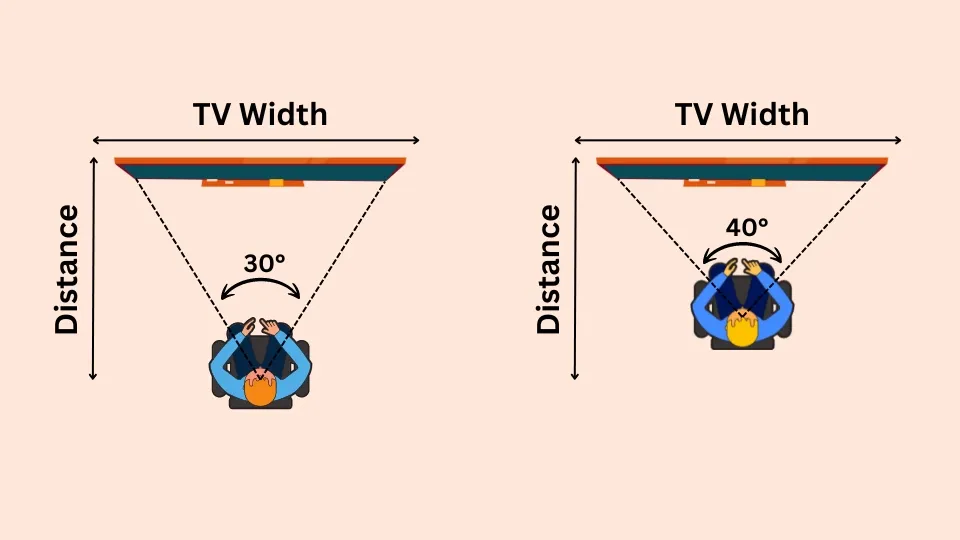TV Size and Viewing Distance Calculator
TV Screen Size Calculator
Width x Height (in):
Width x Height (cm):
Screen Size (cm):
Recommended Viewing Distance (ft):
Recommended Viewing Distance (m):
How to choose the right TV size?
When choosing a TV size, you should consider two primary factors. Firstly, you must have enough space to place your TV. To check this, you can input the TV’s size into a calculator to view its dimensions and assess whether they suit your space.
Secondly, consider the viewing distance, which is the distance between your seat and the TV. You can use tape to measure the distance between your sofa or chair and the place where you will place a TV.
Based on this distance, you can choose the TV of the right size to fit your room best.
How we calculated the recommended viewing distance?
The recommended viewing distance was calculated using the following parameters. As the maximum distance, we take the distance at which the viewing angle will be 30 degrees, as the Society of Motion Picture and Television Engineers (SMPTE) advised. This is a slightly outdated standard from when low-resolution, low-pixel-per-inch TVs were popular and widespread.
To understand what the viewing angle is, take a look at this picture:

Simply put, it’s how many degrees your TV occupies from your entire field of view. Typically, a person can keep about 120 degrees in their field of vision, with center vision (constantly in your focus) around 60 degrees.
Accordingly, the smaller the viewing angle, the farther away you sit from the TV. For low-resolution TVs, it is better to sit farther away so you cannot distinguish pixels when watching a TV.
But nowadays, most new TVs have 4K resolution, so you won’t be able to distinguish pixels even if you sit closer. That’s why you also use the THX standard, which recommended watching a TV with a viewing angle of 40 degrees. Now, they recommend a 15-degree arc based on vertical screen size, but they’re almost the same.
The formula we used to calculate the recommended viewing distance is as follows: Recommended viewing distance = TV diagonal/tan(30 or 40)/12.
Can I sit even closer if I have 4K TV?
Most people’s central vision is about a 60-degree angle. So yes, technically you can sit even closer to get an even more immersive experience. However, this is too close, for example for a 65 inch TV you would only be sitting 3.1 feet (0.94 m) away.
Some companies suggest multiplying the TV’s height by 1.5 to calculate the recommended viewing distance. Sony suggests this in its guide on its official website. Here are their recommendations:
| TV size | Viewing distance |
|---|---|
| 43 inch | 35 inches (2.95 feet) |
| 49 inch | 39 inches (3.28 feet) |
| 55 inch | 39 inches (3.28 feet) |
| 65 inch | 47 inches (3.94 feet) |
| 75 inch | 55 inches (4.59 feet) |
| 85 inch | 63 inches (5.25 feet) |
But these recommendations are not good, in our opinion. This viewing distance may be acceptable for watching a blockbuster or cinematic movie, but for everyday experience, it may be too tiring for your eyes. If you calculate the viewing area according to their advice, it will be even more than 60 degrees for larger diagonals, meaning that even part of the TV will be out of your central vision. That’s why we use the values in the calculator that suit most people.
I want to buy a TV to use it as a home theater, what size can I get?
In a standard movie theater, with an average number of seats, they can usually be divided into three sectors:
- The first rows watch movies with a viewing angle of about 62-67 degrees.
- Closer to the center, the viewing angle will be about 50-54 degrees
- Back rows watching a movie with a viewing angle of about 35-40 degrees.
Suppose you have ever been to a movie theater. You can remember your experience, assess where you were most comfortable watching movies, and choose the distance, depending on your preferences. Here’s a table for closer distances for 4K TVs, for 45-degree, 50-degree, 55-degree, and 60-degree viewing angle:
| TV Size (inches) | 45° Distance | 50° Distance | 55° Distance | 60° Distance |
|---|---|---|---|---|
| 43 | 3.58′ (1.1 m) | 3.01′ (0.9 m) | 2.51′ (0.8 m) | 2.07′ (0.6 m) |
| 50 | 4.17′ (1.3 m) | 3.50′ (1.1 m) | 2.92′ (0.9 m) | 2.41′ (0.7 m) |
| 55 | 4.58′ (1.4 m) | 3.85′ (1.2 m) | 3.21′ (1.0 m) | 2.65′ (0.8 m) |
| 65 | 5.42′ (1.7 m) | 4.54′ (1.4 m) | 3.79′ (1.2 m) | 3.13′ (1.0 m) |
| 70 | 5.83′ (1.8 m) | 4.89′ (1.5 m) | 4.08′ (1.2 m) | 3.37′ (1.0 m) |
| 75 | 6.25′ (1.9 m) | 5.24′ (1.6 m) | 4.38′ (1.3 m) | 3.61′ (1.1 m) |
| 85 | 7.08′ (2.2 m) | 5.94′ (1.8 m) | 4.96′ (1.5 m) | 4.09′ (1.2 m) |
| 95 | 7.92′ (2.4 m) | 6.64′ (2.0 m) | 5.54′ (1.7 m) | 4.57′ (1.4 m) |
If you want more to know about TV sizes, you can read our big guide.
Created by: Anatoliy Mashirenko, Valeriy Artamonov, Vladislav Mashirenko

